“Grand Hotel … always the same. People come, people go. Nothing ever happens.” — Dr. Otternschlag in the film Grand Hotel (1932).
With West 7th Street canyonlands booming and Fort Worth’s museums growing in stature and square footage, developers have been dreaming of a Cultural District boutique hotel. But 60 years ago, a grand little hotel had already opened its elegant lobby to guests at the intersection of Camp Bowie Boulevard and Montgomery Street.
The Colonial Hotel and Apartments played host to more colorful history in three decades than many a better-known establishment did in a century. Over the years, the complex drew tourists and entertainers, stock show carnies, and — toward the end — long-term boarders and rumored prostitutes, drug dealers, and gamblers.
It was the kind of place that seemed to attract stories — wild ones about folks like former football player Joe Don Looney and sad ones about young unwed mothers whose babies would be whisked away. Glory days yielded to inglorious phases, but the stories kept coming. The place, and its basement bar, became a favorite haunt of local musicians and entertainers.
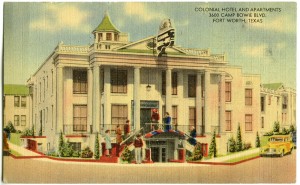
Part of the color and character came from the hotel’s owners. Eleven days after the Japanese attack on Pearl Harbor, Wyatt and Pearl Slaughter bought the land and a cluster of old buildings on it for $18,500. Pearl was a rather flamboyant woman. With her businessman husband, she already owned the Dorothy Lane apartments a few blocks to the northwest, a complex that would develop its own sense of history and set of characters through the years. At the hotel, she could put to use her rather elevated ideas about architecture and décor.
It was a colonial kind of year in Fort Worth in 1941. Marvin Leonard’s Colonial Golf Club hosted the U.S. Open at its palatial, bright-white clubhouse and bentgrass greens just a few miles to the south.
The hotel’s exterior featured stately columns on the portico with a cupola above. The multi-windowed tower replicated one atop an old home next to the Slaughters’ residence on Dorothy Lane; another crowned the roof of a hotel-apartment property above Hulen and Vickery that Pearl eventually turned into the Homestead Maternity Home.
At some point, the hotel’s rather imposing (for Fort Worth) architecture inspired prolific painter Josephine Mahaffey of the Fort Worth Circle — whether on whim or commission isn’t known. (The resulting watercolor is featured on the cover of this issue.)
Mahaffey kept a portable easel in her car. “If she saw a scene around town that she liked, she’d stop and paint it on the spot,” said Scott Barker, co-author with Jane Myers of Intimate Modernism: Fort Worth Circle artists in the 1940s.
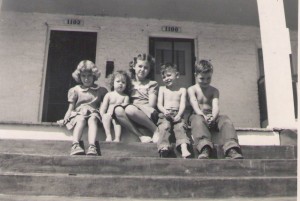
Casa Mañana and other nearby facilities built for the Texas Centennial in 1936 continued in operation and drew customers to the hotel.
Courtney Sproles joined the hotel staff after mustering out of the Merchant Marines at the end of World War II. He was proud of his job, his daughter Cindi Neverdousky, 62, of Willow Park, said. Her late father used to tell her that bellhops had to live up to the job title — he “had to hop to get the job done.”
Ann Bottorff, 70, of Fort Worth, tasted adventure and her first slice of pizza in the Colonial’s coffee shop. “It was 1955, I think. We were 13-year-old girls from the country when my friend’s older brother, home from college, took us to town for a treat,” she remembered. ”We were all dressed up in our full skirts with many petticoats and, I’m sure, garter belts and stockings.
“The café was in the basement, down wide stairs. The tables had checkered cloths with wine-bottle candles. There was a trellis on the wall with artificial grapevines. We were in awe, and the pizza was so exotic.”
********
Pearl, herself the mother of two adopted children, publicly launched a new project in 1958: the Homestead Maternity Home and Child Placement Service. But she really began the home five years before that, quietly installing some of the pregnant women at the Colonial Hotel Apartments. Her nephew, Wyatt Webb, remembered outings to the Fort Worth Zoo and other activities planned for the girls during those years.
Fort Worth Press staff writer Seth Kantor interviewed Pearl for a story late that year. She told him she had begun the practice before she got an official license, in response to an overflow of unwed mothers from another local facility in 1953. The first address for Pearl’s maternity home was 3600 Camp Bowie Blvd. — the hotel’s address. In subsequent years, the home moved to several other locations, including the one on Hulen.
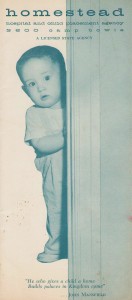
Kantor (who, a few years later, would witness the Kennedy assassination in Dallas) closed his story with a quote:
“Despite this extraordinary touch of charitable work, Mrs. Slaughter does not grow weepy in sentiment with ‘past’ young women,” he wrote. Pearl stated, “I think it’s a lot better not to contact them. They ought to forget the experience and everything connected with it.”
Her words would foreshadow subsequent struggles of many of the Homestead children and their birth mothers, who searched for each other and agonized over the disappearance of the home’s records, which were said to have been lost in a fire.
These days, G’S Adoption Registry, an online community serving adoptees and birthmothers, includes a designated section for Homestead people. Coordinator Gary Schaefer has posted a summary of the agency’s history from 1954 through its final year, 1972.
********
By the 1950s, the Colonial had developed a bit of a wild side. Forest Ratcliff grew up a block from the hotel and heard about the basement bar and its reputation. His parents “thought it was a little shady,” he recalled.
Master plumber Wayne George worked for the Slaughters, both at the hotel and the Dorothy Lane apartments. In the early ’50s, he and his wife and three children, including Wayne Jr. (“Buster”), lived at the hotel for a while.
“It was the most unhappy year of my childhood,” Sylvia George Walls, 70, of Fort Worth, recalled. Their dad liked to spend time in the basement bar, but it was off-limits to the kids. She remembers looking in and seeing an ornate jukebox.
“My daddy had dragged me into bars all over Texas and Louisiana,” Wayne Jr. recalled, “but he wouldn’t let me go in that one.” Now 65, he lives near Azle.
Dan Linden, 57, of Weatherford, had a front row seat for the Colonial’s underground culture.
When he was 12, his family moved to Fort Worth, into one of the apartments associated with the hotel.
“In the lower level of the main hotel building,” he remembered, “my dad [Richard “Dick” Linden] and a business partner [Dave Hanson] ran an after-hours club that was open on Friday and Saturday nights and catered to the late ’60s nightclub crowd.”
The After Owlers Club “would open when the bars closed, and all the local musicians would jam together till about 4 or 5 a.m.,” he said.
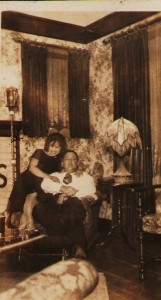
Hanson “was a local celebrity of sorts at that time,” Dan Linden remembered. “My dad learned to play the old stand-up bass, and he played with Dave and some other musicians at the local clubs.”
Veteran blues guitarist Sumter Bruton, 67, visited the Colonial bar a few times during his younger years. “You want to know what it was like?” he asked. “Rent the film Barfly.”
Nick Loesch of Weatherford remembered hanging out in the basement bar when he worked at then-General Dynamics (now Lockheeed Martin) beginning in 1967 when, at 20, he was too young to buy a drink legally.
“What a dive it was, but we had a heck of a good time drinkin’ cheap beer and playing pool,” he said. “It was basically one large room –– bar down the west side, couple of pool tables on the north side by the back door and the stairs up to the parking lot, dark, damp — smelled of piss and beer by the restrooms. … No AC until it got to about 100 outside, fans and cold beer. I made sure I was gone before the professional drunks arrived — I hated fighting.”
Most flamboyant of the bar’s habitués was the late and legendary Joe Don Looney, volatile ex-Texas Christian University and NFL football star. In a 1980 Texas Monthly article, Michael T. Shropshire chronicled one Looney incident:
“Just the other night in a Fort Worth bar, I overheard somebody recalling one night back in ’65 when Joe Don Looney chased a Golden Gloves boxer named Winchell eight blocks from the old Colonial Motel [sic] all the way to the parking lot behind the Office Club. Winchell, terrorized, locked himself in the trunk of his own automobile.
“That much of the story is true,” Shropshire wrote. “The rest of the story, about Joe Don trotting over to the 7-Eleven for a quart of beer and splashing it all over Winchell’s car and telling him it was gasoline he was fixing to light, is fiction, I think.”
Another, more dramatic legend involved a feat of incredible strength. In that scenario, Looney raged at the jukebox, then somehow hauled it out onto the sidewalk.
Rick Benedict, 61, of Burleson, a Trinity Park music scene follower in the late 1960s and now entertainment director for the annual Trinity Park Music Reunion, once had bohemian designs on the Colonial’s depths.
“We tried to turn the coffee shop downstairs into a hippie hangout in ’67-’68,” he noted. It never came to be.

By that time, the bigger stars who performed at Casa Mañana tended to stay at the tonier (and now also long-gone) Hotel Loring, but some theater folks still checked into the nice-but-getting-shabby rooms of the Colonial.
Meanwhile, entertainment of another sort was apparently afoot in some of the rooms.
Monte Knutson, 84, and Peter De Leon, 66, both longtime residents of the Arlington Heights neighborhood, collaborated on their memories of the hotel. They agreed that the basement bar was a neighborhood watering hole. And they remembered a friend whose grandmother had moved some of her prostitutes into the Colonial after they were ousted from a Northside venue.
“A gentleman would come into the bar and pay a lady’s bar bill, and then they would go upstairs for a short spell,” Knutson and De Leon wrote. “Some ladies would certainly run up a lot of bar bills during the evening.” Their mutual friend and his madam-grandma are both long dead, they said.
Jim Palmer, 66, who served as both a police officer and as a journalist in Fort Worth, recalled the Colonial as it became progressively seedier. He remembered a drug raid there in 1960 and a fire two years later. “And in 1965 there was a police character who was shot there and survived. I’m told the place became a pretty frequent gambling site,” he said.
********
Another fire delivered the coup de grace in the early morning hours of July 10, 1968. It started in the lounge, where paint stored for redecorating the coffee shop helped feed the flames, according to the Fort Worth Star-Telegram report. The six people who were evacuated were described not as hotel guests but rather as roomers.
As the Colonial was descending into disrepair and disrepute, the osteopathic community was enlarging its foothold in the Arlington Heights area. They wanted a larger hospital, a college, and more. With help and influence from Amon G. Carter and Sid W. Richardson, the Amon Carter Foundation, and Carter’s personal physician, Dr. Phil Russell, Fort Worth Osteopathic Hospital sought out Pearl and other property owners to buy their land for its campus.
Single-family bungalows, duplexes, garage apartments, and other residential buildings disappeared. Pearl’s hotel and apartment properties, bordered by Camp Bowie and Montgomery, Bertrose, and Buford streets, sold for about $135,000.
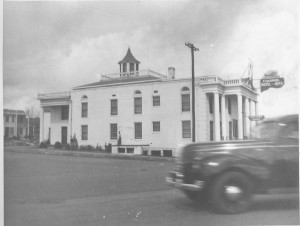
After condemnation notices appeared on the porches of the Colonial’s apartments, Ada B. Estill, who lived nearby, picked wild plums from trees growing around the soon-to-be-razed buildings. She carried them home to her kitchen and transformed them into jelly.
When the hotel came down, a few of its parts evidently were salvaged. Robert McDaniel, 63, of Fort Worth, recalled that his stepfather worked with a builder who bought the Colonial’s columns and installed them in the front of his house in Colleyville. “I actually saw them there,” he said. “So cool!”
Long after the last chunks of brick and plaster rode away on dump trucks and the wrecked jukebox ceased playing, the Colonial haunts.
Knutson and De Leon recalled the last days of the landmark, when it “gave one last great display. … When the wrecking ball exposed the Colonial Hotel’s interior rooms, they were revealed individually, painted in bright solid colors of white, yellow, red and turquoise, which were stunning in the full Texas sun.”
Historian Juliet George can be reached at julietgeorge7@sbcglobal.net.



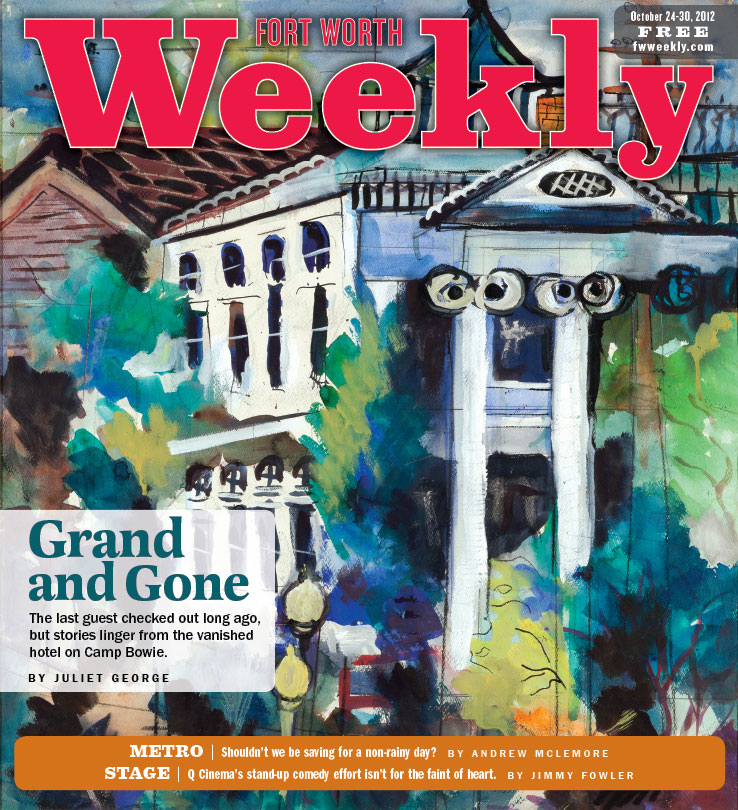









As a little girl living two or three blocks up from Camp Bowie on Bertrose, I remember my Dad sending me to the Colonial Hotel to buy cigarettes for him. He would write a note and give it to me since I was a minor. Even then – in the mid-forties – he called them ‘cancer sticks’, so we knew long ago of the dangers of smoking – he did, anyway. Little did I or my brothers know at the time about any of the ‘other stuff’ happening there; only that they sold cigarettes. The Will Rogers Coliseum on the other side of Camp Bowie and the grounds nearby were our playground at times. There was a creek, as I remember, and golf balls on the ground in places. Driving range there? Don’t remember. Also went to that area to get ‘free’ typhoid shots after the floods which hit Fort Worth hard, inundating the area, including the well-known and celebrated Botanical Gardens. I believe Polio was a huge problem at that time, but cannot remember when the Salk Vaccines were introduced. (God bless Jonas Salk).